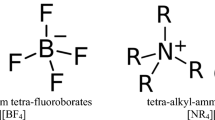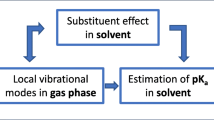Abstract
A group-contribution method has been developed to estimate the heat of sublimation (ΔH sub) at the triple point for organic solids. The correlation was developed using ΔH sub values from a training set of 218 compounds, and it was tested by comparing predicted and solid vapor pressures for 87 compounds (1103 data points). The predicted solid vapor pressures were obtained from the ΔH sub correlation using the Clausius–Clapeyron equation. The absolute average deviation in the logarithm of vapor pressure was 0.371. The new method compares favorably with Bondi's method for prediction of ΔH sub and represents an improvement over other available methods for predicting solid vapor pressures.
Similar content being viewed by others
REFERENCES
R. L. Rowley, W. V. Wilding, J. L. Oscarson, N. A. Zundel, T. L. Marshall, T. E. Daubert, and R. P. Danner, DIPPR ®istered< Data Compilation of Pure Compound Properties (Design Institute for Physical Properties, AIChE, New York, 2002).
D. Ericksen, W. V. Wilding, J. L. Oscarson, and R. L. Rowley, J. Chem. Eng. Data 47:1293(2002).
T. A. Knotts, W. V. Wilding, J. L. Oscarson, and R. L. Rowley, J. Chem. Eng. Data 46:1007(2001).
B. T. Goodman, W. V. Wilding, J. L. Oscarson, and R. L. Rowley, J. Chem. Eng. Data 49:24(2004).
TSAR Version 3.2 (Oxford Molecular Group, Oxford Molecular Limited, Oxford, 1998).
D. Wininger, Chem. Inf. Comput. Sci. 28:31(1998).
SMILES Tutorial (1998), www.daylight.com/smiles/f_smiles.html.
A. Bondi, J. Chem. Eng. Data 8:371(1963).
A. Bondi, Physical Properties of Molecular Crystals, Liquids and Glasses (Wiley, New York, 1968), pp. 453-479.
D. MacKay, A. Bobra, D. W. Chan, and W. Y. Shlu, Environ. Sci. Technol. 16:645(1982).
E. Neau, S. Gamier, and L. Avaullee, Fluid Phase Equilib. 164:173(1999).
L. Constantinou and R. Gani, AIChE J. 40:1697(1994).
L. Constantinou, R. Gani, and J. P. O'Connell, Fluid Phase Equilib. 103:11(1995).
L. Coniglio, L. Trassy, and E. Rauzy, Ind. Eng. Chem. Res. 39:5037(2000).
L. Coniglio, Thesis (Université d'Aix-Marseille III, 1993).
L. Trassy, Thesis (Université de la Méditerranée, 1998).
L. Avaullée, L. Trasy, E. Neau, and J. N. Jaubert, Fluid Phase Equilib. 139:155(1997).
Author information
Authors and Affiliations
Corresponding author
Rights and permissions
About this article
Cite this article
Goodman, B.T., Wilding, W.V., Oscarson, J.L. et al. Use of the DIPPR Database for the Development of QSPR Correlations: Solid Vapor Pressure and Heat of Sublimation of Organic Compounds. International Journal of Thermophysics 25, 337–350 (2004). https://doi.org/10.1023/B:IJOT.0000028471.77933.80
Issue Date:
DOI: https://doi.org/10.1023/B:IJOT.0000028471.77933.80




